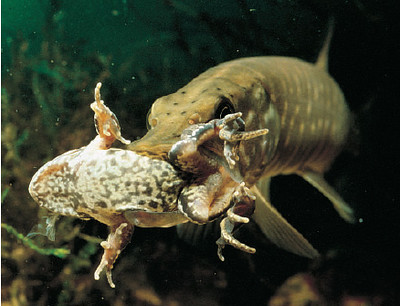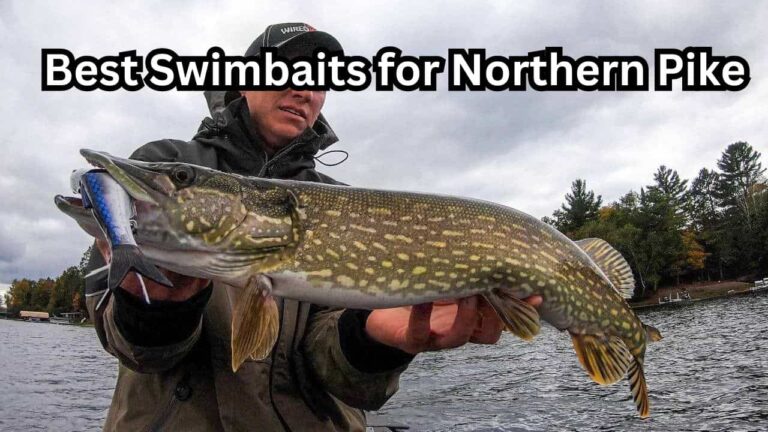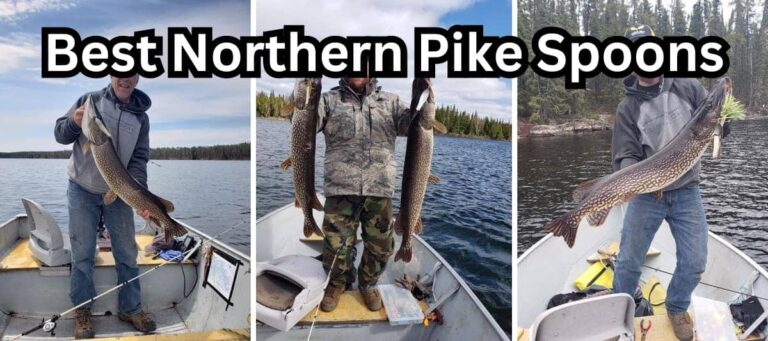What Do Pike Eat? And Which Lures Mimic Pike Forage

The simplest answer is that pike eat anything that fits into their mouth.
But of course, I am sure that answer doesn’t satisfy you. Pike certainly do have favorite types of forage.
There are also many limitations to what pike can eat do to the habitats and locations where pike live.
What Do Pike Eat?
1. Shiner
https://barbcatchfishing.com/wp-content/uploads/2024/01/XJZAE23321.mov
When a school of shiners is spotted, pike use their streamlined bodies and powerful tails to swiftly close in, relying on precision and speed to engulf their prey with their sharp teeth.
Key locations for this interaction include shallow bays, weed beds, and areas with cover, creating a dynamic ecosystem where predator and prey engage in a perpetual dance of survival.
Best Shiner Imitation Lure: Spoon
A spoon is one of the simplest yet most effective pike lures. The shiny, metal spoon swims and flashes through the water.
Shiner are very reflective baitfish that reflect light and flash very similar to a spoon lure. You can’t go wrong throwing a spoon for pike feeding on shiner.
2. Perch
Pike and perch commonly share habitats, making perch a favorite forage for pike.
These predatory fish inhabit similar areas, including submerged vegetation, fallen trees, and rocky structures.
The coexistence of pike and perch in these environments creates a dynamic interplay between predator and prey.
Perch reach fairly substantial sizes, making them a hardy and satisfying meal for big Northern pike.
Best Perch Imitation Lure: Swimbait
Big paddle or curl tail swimbaits have become the favorite lure of most pike fisherman.
These lures are very realistic and seem to mesmerize pike into biting. Perch colored swimbaits match the hatch perfectly.
You can get them in bright colors or more natural ones depending on the water conditions.
3. Crayfish

Crayfish (or crawfish) are typically thought of as a favorite forage for largemouth, smallmouth, and spotted bass.
But they don’t get enough recognition amongst pike anglers. Pike absolutely love crayfish and feed on them all year round.
Up in the Northern states, most lakes, rivers, and ponds have very rocky bottoms and structures which make the perfect habitat for crayfish.
Any time there lots of crayfish, there will be predators looking to eat them. Northern pike feed on them very heavily.
Best Crayfish Imitation Lure: Chatterbait
Now, if I was talking about crayfish lures for bass, my answer would be a bit different.
But when it comes to pike that are feeding on crayfish, chatterbaits seem to produce the best bites.
I think that a crawfish crankbait gets a few more bites, but they tend to be from smaller pike.
Chatterbaits trigger bites from small, medium, and large pike. A dark red or brown chatterbait is my go-to crayfish imitation when pike fishing.
4. Pickerel and Small Pike
Most predatory fish are cannibalistic, and pike are no exception. Big pike won’t hesitate to gobble up a small pike or pickerel that passes by them.
This is usually a tougher meal because pike and pickerel are very fast and elusive, so it can be hard for the big pike to catch them. But adult pike certainly will eat their own kind.
Best Pickerel and Pike Imitation Lure: Swimbait
The paddle tail and curl tail swimbaits are probably the more versatile and reliable lure options.
But there are jointed and soft plastic swimbaits designed to exactly imitate small pickerel and pike.
The do trigger bites from very aggressive pike, but I have found that the standard pike swimbaits work a bit better.
Pike jerkbaits are also great lures to mimic this forage.
5. Reptiles and Amphibians

If a frog, lizard, snake, or other creature is unlucky enough to find itself in the water, pike will eat them without hesitation.
Pike don’t feed very heavily on these creatures because up in the Northern areas where pike primarily live, there are much less reptiles and amphibians.
So even though they aren’t a primary forage source, pike still love to eat them.
Best Amphibian Imitation Lure: Hollow Body Frog
It is pretty much impossible to beat the classic hollow body frog in this category.
They are a completely weedless pike lure that you can fish anywhere.
Now like I discussed, pike don’t primarily feed on frogs and other reptiles, so I only ever tie on a frog lure if I’m fishing super thick grass and vegetation.
Because of this, the frog is a particularly good summer lure for pike.
FAQ
Q: How do pike catch their prey?
A: Pike are ambush predators, relying on stealth and speed. They often lurk near submerged vegetation or structures, then swiftly strike with their streamlined bodies and sharp teeth when prey, like perch or shiners, is detected.
Q: Where can one find pike hunting for food?
A: Pike are commonly found in various freshwater environments, including lakes, rivers, and ponds. They prefer habitats with abundant vegetation, fallen trees, or rocky structures where potential prey, like perch and shiners, congregate.
Q: Why are perch and shiners favorites for pike?
A: Pike and perch share similar habitats, creating an environment where both species coexist. This proximity makes perch and shiners easily accessible prey for pike, contributing to their status as favorite forages.
Q: Do pike eat anything besides fish?
A: While fish make up a significant portion of their diet, pike are opportunistic feeders and may also consume aquatic insects, frogs, and even small mammals when available.
Q: How do pike contribute to the ecosystem by hunting perch and shiners?
A: The predation dynamics between pike, perch, and shiners contribute to a balanced freshwater ecosystem. Pike help control the populations of smaller fish, preventing overpopulation and promoting ecological equilibrium.
Q: Are pike a threat to other fish species?
A: Pike can pose a threat to smaller fish species, especially those that share their habitat. However, their role as predators is essential in maintaining the overall health and balance of the aquatic ecosystem.
Q: Can pike adapt their diet based on environmental changes?
A: Yes, pike are adaptable predators. They may adjust their diet based on seasonal variations, environmental changes, and the availability of different prey species in their habitat.
Also Read: 5 Best Pike Spoons
Reeling this In
So yes, pike will eat pretty much anything around them as long as it can fit in their mouth.
But because of habitat and available forage, they focus on shiner, perch, crayfish, other pike, and the occasional frog, snake, or lizard.
There are tons of great pike lures, but if you know what your pike are feeding on, you can dial in your lure choice to best match the hatch.






